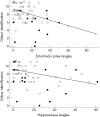The relationship between cerebral Alzheimer's disease pathology and odour identification in old age
- PMID: 17012338
- PMCID: PMC2117790
- DOI: 10.1136/jnnp.2006.099721
The relationship between cerebral Alzheimer's disease pathology and odour identification in old age
Abstract
Background: Olfactory dysfunction is common in old age, but its basis is uncertain.
Objective: To test the hypothesis that difficulty in identifying odours in old age is related to the accumulation of Alzheimer's disease pathology.
Methods: As part of the Rush Memory and Aging Project, participants completed the 12-item Brief Smell Identification Test, a standard measure of odour identification. During a mean (standard deviation (SD)) of 2.2 (1.2) years of follow-up (range 0.2-4.9), 166 people died, with brain autopsies performed on 129 (77.7%) people and neuropathological examinations completed on 77 (mean (SD) age at death 87.5 (5.9) years; median postmortem interval 6.1 h). From a uniform postmortem examination of multiple brain regions, summary measures of plaque and tangle pathology were derived on the basis of silver staining, and those of amyloid beta burden, tangle density and Lewy bodies on the basis of immunohistochemistry.
Results: Odour identification performance ranged from 0 to 12 correct (mean (SD) 8.0 (2.6)). In analyses adjusted for age, sex and education, a composite measure of plaques and tangles accounted for >12% of the variation in odour identification. The association remained after controlling for dementia or semantic memory. Density of tau tangles was inversely related to odour identification. A similar effect for amyloid burden was attenuated after controlling for tangles. The association with odour identification was robust for tangles in the entorhinal cortex and CA1/subiculum area of the hippocampus, but not for tangles in other cortical sites. Lewy bodies, identified in 12.5%, were not related to odour identification, probably partly due to to their relative infrequency.
Conclusion: The results suggest that difficulty in identifying familiar odours in old age is partly due to the accumulation of neurofibrillar pathology in central olfactory regions.
Conflict of interest statement
Competing interests: None.
References
MeSH terms
LinkOut - more resources
Full Text Sources
Medical
Research Materials
Miscellaneous



